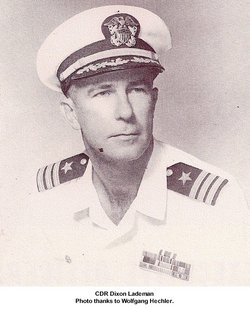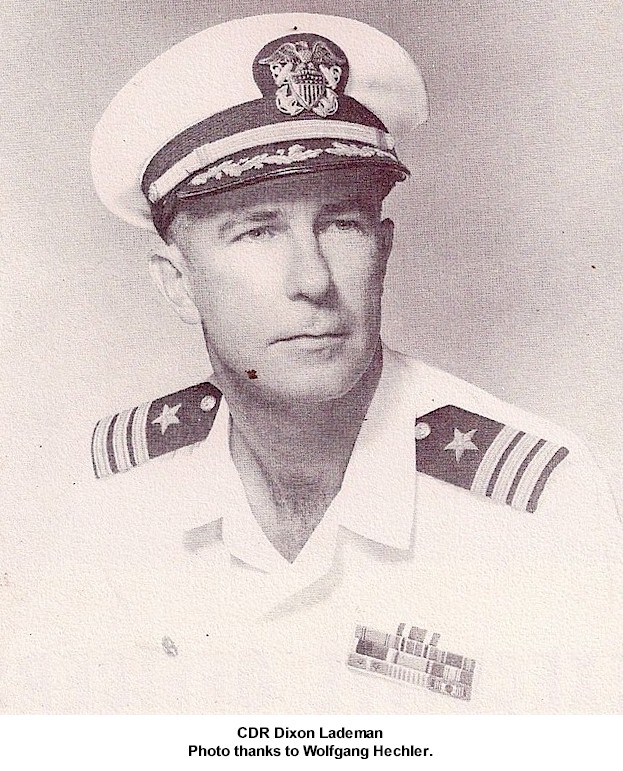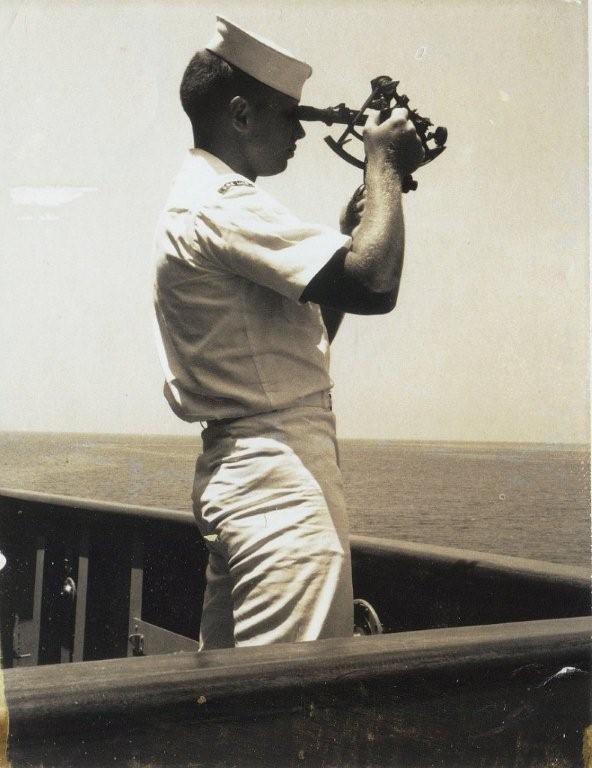LT Dixon Lademan, USN - United States Naval Academy Class of 1946
The Development and Evolution of The FBM System - A Class of 1946 Cold War Story
By RADM Robert H. Wertheim, USN (Ret.)
NOTE: Here is a list of my 1946 classmates who played significant roles is this story:
Dixon Lademan, who served tours in SP in POLARIS missile technical plans and later in POSEIDON test operations.
Dixon McCully Lademan (1924-2003), was a captain in the U.S. Navy in World War II, the Korean War, and the Vietnam War.
USS Gallant (MSO-489)
The second Gallant (AM-489) was laid down on 21 May 1953 by J. M. Martinac Shipbuilding Corp., Tacoma, Washington; launched on 4 June 1954; sponsored by Mrs. Walter Meserole; reclassified (MSO-489) on 7 February 1955; and commissioned as Gallant (MSO-489) at Tacoma on 14 September 1955, Lieutenant Dixon Lademan in command.
SABOTAGE OF MINESWEEPERS INWONSAN BAY, 1951-1952
By Burl E. Gilliland, CAPT, USNR, Retired
Then, one evening, as the three minesweepers were anchored, having our evening meal, in a cove off a small island inside Wonsan Bay, we suddenly received a message from the quartermaster of the watch that the FIRECREST was getting underway. We rushed out on deck to see the FIRECREST circling what looked like a bale of straw that was floating directly toward where we were anchored. Our ships used an operational voice radio communications system that was very informal. We used the skipper's first name, as a ship identifier, in talking to a particular ship. The skipper of the FIRECREST was LTAL SMITH. The skipper of my ship, the HERON was LTJG DIXON LADEMAN. So the voice communication would go something like: "Al,this is Dixon, over." "Dixon, this is Al, we just got underway because this bale of straw looks very suspicious, so we're going to check it out, over." "Al, that looks just like any other dumb bale of straw, so we're staying put,over." "Dixon, I suggest that you get underway immediately,because we cannot fire on the bale of straw because you're right in our line of fire and the thing is headed directly your way in the current, over."
USS Firecrest, AMS-10. Lead ship in MINDIV54
These three ships of MINDIV 54 were operating as a unit with LT AL SMITH serving as OTC (Officer-in-Charge) because the Division Commander, LCDR JANECKEY was not present. So ALSMITH, being senior, meant that the FIRECREST and its CO was in charge at the scene. AL SMITH was a Mustang (former enlisted man, having advanced up through the hierarchy to officer status and CO of the minesweeper).Both skippers were outstanding officers and ship handlers and both of them were exceptionally experienced minesweeper officers. But for some reason, that day, DIXON LADEMAN declined AL SMITH's suggestion to get the HERON underway. It was only a suggestion, not an order. (During previous months we had seen many bales of straw and other items float harmlessly by, so I felt no danger and I don't believe my shipmates felt any danger from that particular bale of straw either). I distinctly remember most of the HERON crew standing out on the main deck laughing and watching the FIRECREST as it circled the bale of straw until the straw came right up along our portside. It came within a few feet of the HERON. As it floated by, I could clearly see the joints in the stalks of straw.
50 YEARS AGO:
Missile dropped on Mayport ship, Navy says nuclear warhead unarmed
by: Max Marbut Associate Editor
An unarmed, two-stage missile tipped with a nuclear warhead accidently was dropped several feet to the deck of the guided missile frigate Luce at Mayport Naval Station, but did not explode.
When word of the accident spread, hundreds of residents began to panic and flooded the base’s switchboard, believing the missile might be in danger of detonating.
The danger of the accident lay in the fact that the missile’s high-explosive propellant could have exploded, scattering nuclear or radioactive material around a large area.
“I feel as safe around one of these missiles if it dropped as a five-inch bullet,” said Capt. Dixon Lademan, commanding officer of the Luce.
He said the odds of the warhead detonating or the propellant igniting after being dropped were “more than a million to one.”
Guided missile frigates such as the Luce were equipped to carry 40 Terrier missiles. The weapons were 31 feet long and were fired at supersonic speeds to a range of 10 nautical miles.
LT Dixon Lademan, USN - United States Naval Academy Class of 1946
The Development and Evolution of The FBM System - A Class of 1946 Cold War Story
By RADM Robert H. Wertheim, USN (Ret.)
NOTE: Here is a list of my 1946 classmates who played significant roles is this story:
Dixon Lademan, who served tours in SP in POLARIS missile technical plans and later in POSEIDON test operations.
Dixon McCully Lademan (1924-2003), was a captain in the U.S. Navy in World War II, the Korean War, and the Vietnam War.
USS Gallant (MSO-489)
The second Gallant (AM-489) was laid down on 21 May 1953 by J. M. Martinac Shipbuilding Corp., Tacoma, Washington; launched on 4 June 1954; sponsored by Mrs. Walter Meserole; reclassified (MSO-489) on 7 February 1955; and commissioned as Gallant (MSO-489) at Tacoma on 14 September 1955, Lieutenant Dixon Lademan in command.
SABOTAGE OF MINESWEEPERS INWONSAN BAY, 1951-1952
By Burl E. Gilliland, CAPT, USNR, Retired
Then, one evening, as the three minesweepers were anchored, having our evening meal, in a cove off a small island inside Wonsan Bay, we suddenly received a message from the quartermaster of the watch that the FIRECREST was getting underway. We rushed out on deck to see the FIRECREST circling what looked like a bale of straw that was floating directly toward where we were anchored. Our ships used an operational voice radio communications system that was very informal. We used the skipper's first name, as a ship identifier, in talking to a particular ship. The skipper of the FIRECREST was LTAL SMITH. The skipper of my ship, the HERON was LTJG DIXON LADEMAN. So the voice communication would go something like: "Al,this is Dixon, over." "Dixon, this is Al, we just got underway because this bale of straw looks very suspicious, so we're going to check it out, over." "Al, that looks just like any other dumb bale of straw, so we're staying put,over." "Dixon, I suggest that you get underway immediately,because we cannot fire on the bale of straw because you're right in our line of fire and the thing is headed directly your way in the current, over."
USS Firecrest, AMS-10. Lead ship in MINDIV54
These three ships of MINDIV 54 were operating as a unit with LT AL SMITH serving as OTC (Officer-in-Charge) because the Division Commander, LCDR JANECKEY was not present. So ALSMITH, being senior, meant that the FIRECREST and its CO was in charge at the scene. AL SMITH was a Mustang (former enlisted man, having advanced up through the hierarchy to officer status and CO of the minesweeper).Both skippers were outstanding officers and ship handlers and both of them were exceptionally experienced minesweeper officers. But for some reason, that day, DIXON LADEMAN declined AL SMITH's suggestion to get the HERON underway. It was only a suggestion, not an order. (During previous months we had seen many bales of straw and other items float harmlessly by, so I felt no danger and I don't believe my shipmates felt any danger from that particular bale of straw either). I distinctly remember most of the HERON crew standing out on the main deck laughing and watching the FIRECREST as it circled the bale of straw until the straw came right up along our portside. It came within a few feet of the HERON. As it floated by, I could clearly see the joints in the stalks of straw.
50 YEARS AGO:
Missile dropped on Mayport ship, Navy says nuclear warhead unarmed
by: Max Marbut Associate Editor
An unarmed, two-stage missile tipped with a nuclear warhead accidently was dropped several feet to the deck of the guided missile frigate Luce at Mayport Naval Station, but did not explode.
When word of the accident spread, hundreds of residents began to panic and flooded the base’s switchboard, believing the missile might be in danger of detonating.
The danger of the accident lay in the fact that the missile’s high-explosive propellant could have exploded, scattering nuclear or radioactive material around a large area.
“I feel as safe around one of these missiles if it dropped as a five-inch bullet,” said Capt. Dixon Lademan, commanding officer of the Luce.
He said the odds of the warhead detonating or the propellant igniting after being dropped were “more than a million to one.”
Guided missile frigates such as the Luce were equipped to carry 40 Terrier missiles. The weapons were 31 feet long and were fired at supersonic speeds to a range of 10 nautical miles.
Inscription
Commander US NAVY, WORLD WAR II, KOREA, VIETNAM
Family Members
Sponsored by Ancestry
Advertisement
Advertisement









